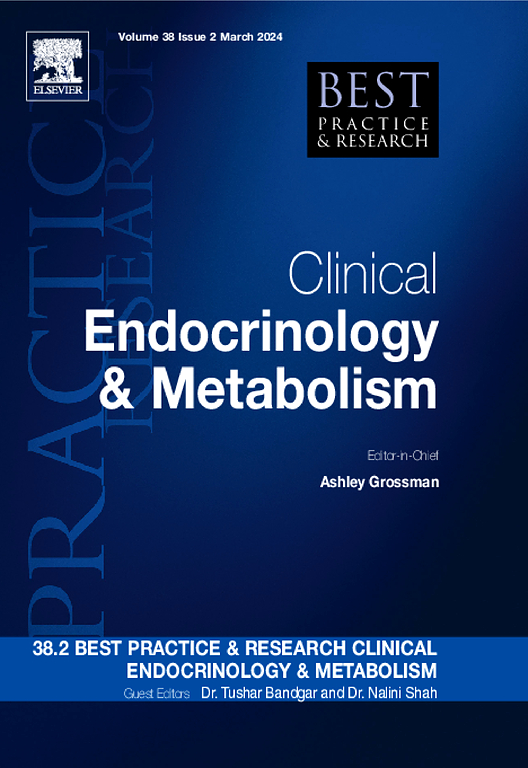Ectopic craniopharyngiomas
IF 6.1
1区 医学
Q1 ENDOCRINOLOGY & METABOLISM
Best practice & research. Clinical endocrinology & metabolism
Pub Date : 2025-09-01
DOI:10.1016/j.beem.2025.102047
引用次数: 0
Abstract
Craniopharyngiomas (CPs) are rare embryonic malformational tumours of the sellar/parasellar region, classified by the World Health Organization (WHO) 5th edition as grade 1 tumours. They may arise anywhere on the path of embryonic cell migration between the midline sphenoid bone and the floor of the sella turcica. On rare occasions, they can be found remotely in areas like the nasopharynx, the orbit, the posterior fossa, the brain parenchyma and the spine. Such ectopic CPs may present as primary in an atypical location, or as secondary, which represent distant recurrence after initial surgical excision in an orthotopic location. The pathogenesis of primary and secondary ectopic CPs is considered distinct, reflecting differences in developmental biology versus tumour dissemination. Primary ectopic CPs are thought to arise either from embryologically misplaced tissue or from genetically driven tumourigenesis outside the sella. Pathogenesis of secondary ectopic CPs reflects tumour cell dissemination through surgical tract implantation, cerebrospinal fluid (CSF) seeding or meningeal seeding. Ectopic cases pose unique diagnostic and therapeutic challenges. In this review which encompasses 97 cases (42 primary and 55 secondary ectopic CPs) published during the period, 2000–2025, we discuss the pathogenesis, clinical presentation, diagnosis and management of these distinctive tumours.
异位的适应证。
颅咽管瘤(CPs)是罕见的鞍区/鞍旁区胚胎畸形肿瘤,被世界卫生组织(WHO)第5版列为1级肿瘤。它们可能出现在蝶骨中线和蝶鞍底之间的胚胎细胞迁移路径上的任何地方。在极少数情况下,它们可以在鼻咽部、眼眶、后窝、脑实质和脊柱等遥远的区域被发现。这种异位CPs可能在非典型部位表现为原发性,也可能是继发性,在原位部位进行首次手术切除后远处复发。原发性和继发性异位CPs的发病机制被认为是不同的,反映了发育生物学与肿瘤传播的差异。原发性异位CPs被认为是由胚胎错位的组织或由遗传驱动的鞍外肿瘤发生引起的。继发性异位CPs的发病机制反映肿瘤细胞通过手术道植入、脑脊液(CSF)播种或脑膜播种播散。异位病例提出了独特的诊断和治疗挑战。本文回顾了2000-2025年期间发表的97例(42例原发性和55例继发性异位CPs),讨论了这些独特肿瘤的发病机制、临床表现、诊断和治疗。
本文章由计算机程序翻译,如有差异,请以英文原文为准。
求助全文
约1分钟内获得全文
求助全文
来源期刊
CiteScore
11.90
自引率
0.00%
发文量
77
审稿时长
6-12 weeks
期刊介绍:
Best Practice & Research Clinical Endocrinology & Metabolism is a serial publication that integrates the latest original research findings into evidence-based review articles. These articles aim to address key clinical issues related to diagnosis, treatment, and patient management.
Each issue adopts a problem-oriented approach, focusing on key questions and clearly outlining what is known while identifying areas for future research. Practical management strategies are described to facilitate application to individual patients. The series targets physicians in practice or training.

 求助内容:
求助内容: 应助结果提醒方式:
应助结果提醒方式:


